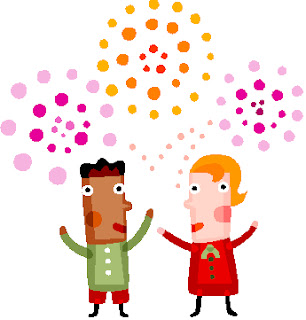You can see the gleaming of the crystals; this painting is DRY, but it looks shiny as if it were wet.
This was very interesting, and added a new dimension as an art medium, so I wanted to try using actual paint instead of food coloring, and see what that would look like. It worked well, except that on my first try I let the water and Epsom salt get too hot-- they were boiling-- and the mixture turned crystally and thick instead of being clear and liquid (as it should look when dissolved completely).
Here's what the too-thick boiled mixture looked like after mixing in paint:
If you paint with this, it is very globby and doesn't stick well to the paper; so after trying it out I decided to start over, and make sure to watch the mixture while cooking.
To my new batch I added acrylic paint (about a teaspoon in each small cup) and stirred it well.
Here it is before and after stirring:
The paint mixture was less watery than when we used food coloring, but it was easy to use-- it flowed along on the brush just fine.
Here are some pictures made using the paint:
Would you like to make some crystally pictures like this? It's very easy to make the mixture (equal parts Epsom salt and water, put on medium heat and stir just until dissolved); I think next we'll experiment with using Kool-Aid as a dye; I'm wondering if we can get bright colors but keep the watery feel.

















































